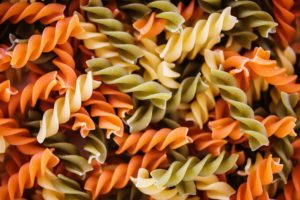By Francesca Wilson, B.A. Exercise Science, ACE Certified Personal Trainer, Precision Nutrition Level 1 Coach
Everyone is talking carbs. Like should I be “watching them?” And the question then becomes what does “watching my carbs” even mean? Because… it seems like everyone is doing it but not many of my clients are clear on any type of specifics. Well I’ve got exciting news! The magical answer to carbs is easy: IT DEPENDS. It depends on your fitness goals, it depends on what you tolerate, it depends on what you like, it depends on your genetics, it depends on your intake of fats and proteins, it depends on your age, it depends on the frequency and intensity of your activity, it depends on how lean you are and it depends on your basal metabolic rate. THERE ARE NO MAGICAL CARB HACKS! Have I mentioned how much I hate the word hack? Especially when it is used in conjunction with dietary information? I digress.
I decided that what we needed was more clear information that will be relatable for our clients. So here is our series on carbs!
Carbohydrates: Part 1 – Um… So What Are Carbs Anyway?
First off let’s get a definition straight. A carbohydrate is any of a large group of organic compounds occurring in foods and living tissues including sugars, starch, and cellulose. They contain hydrogen and oxygen in the same ratio as water (2:1) and typically can be broken down to release energy in the animal body. In the nutrition world we usually see carbohydrates divided into three groups based on complexity.
Monosaccharides have one sugar group, they are the simplest form of carbohydrates and if they were any “smaller” they wouldn’t be considered a carbohydrate molecule anymore.
- Fructose – Fruits, vegetables and honey
- Glucose – Small amounts are found in some fruits, vegetables and honey, manufactured foods
Oligosaccharides have a few sugar groups (usually two or three), they are still a simple form of carbohydrate and easy for our body to breakdown.
- Sucrose – Derived from sugar cane and sugar beet, sweet root vegetables such as beetroot and carrots, table sugar, manufactured foods
- Maltose – Malted wheat and barley, malt extract, beer
- Lactose – Milk, milk products
- Trehalose – Mushrooms and edible fungi
- Raffinose, stachyose, verbascose, inulin, fructo and galacto-oligosaccahrides – Legumes, onions, artichoke, fennel, asparagus, pre-biotics
Polysaccharides have long linked sugar groups that can be branched or long single lines, in layman’s terms this is mostly starch and fiber. These take a while for our body to pull apart into each sugar group
- Starch – Cereal foods, potatoes, small amounts in other root vegetables and unripe fruit
- Non-starch polysaccharides – Vegetables, fruit, wholegrain cereals, pulses (dried edible seeds of certain plants in the legume family)
You can think of a carbohydrate molecule as a bunch of links together forming a chain. A single link is a monosaccharide. An oligosaccharide is 2 or 3 links (which is a very short chain, if we are staying with that analogy) while a polysaccharide is a much longer chain with a lot of links.
In food terms anything sweetened with sugar, fruit juice, fruits, honey, syrups, malted wheat and barley, beer, milk, processed foods or foods made with high fructose corn syrup is higher in monosaccharides and oligosaccharides. While usually vegetables, legumes and whole grains are higher in polysaccharides.
Most carbohydrate breakdown happens in the small intestine where pancreatic amylase breaks any long chains into the individual monosaccharide end product and ships them off to the liver. The liver stores some of these monosaccharides then and in turn sends specifically the glucose out into the bloodstream. Glucose is taken up into cells and used for energy. Our body uses the monosaccharide glucose for most of its energy needs.
The cells of our body are taking glucose out of the bloodstream all the time to do their regular “cell things” like producing enzymes and doing active transfer across cell membranes. So our body likes to have a homeostatic level of about 20g of glucose in the bloodstream at all times, no more, no less. Since we know cells are taking up glucose all the time we also know the liver is releasing glucose in accordance with our cell’s uptake of it. If we are consistently providing a steady stream of carbs to the liver and blood sugar is easily staying at 20g then the body basically turns down the dial on burning dietary fat and stores most fat we ingest for later. Less commonly, if we are taking in a lot lot lot of glucose and other carbohydrates the liver will convert extra into triglycerides, which is just a fancy way of saying body fat.
Our liver is able to store about 80-100g of carbs and our muscles are able to store 300-600g of carbs depending on size and muscular development. A 12oz. can of soda has about 40g of sugar in it. That is 2 hours of blood sugar right there. One cup of blue box prepared mac and cheese has 47g of carbs which can mostly all be converted to glucose, so that is another 2.5 hours of blood sugar. A single Entemann’s doughnut has 30g of carbs half of which are the monosaccharide form. The point I’m trying to make is that it is EASY to get sufficient carbs in our diet.
Here’s the problem: It is also easy to get dietary fat and fat is even more energy dense than carbs. Our body is good at burning fat and prefers to do so most of the time. However, when we bombard the body with simple dietary monosaccharides and oligosaccharides instead of polysaccharides the body needs to figure those out first to keep homeostasis in the bloodstream. Our blood sugar MUST remain at about 20g. So if there are a lot of extra carbs in your dietary choices, they are being burned or stored as fat, and then fat you are eating is also being stored as fat because you are eating so many simple carbs your body can’t even burn the fat you are eating… you see where I’m going with this?
We will dive in more next time with Carbohydrates: Part 2 – Why Do Carbs Get a Bad Rap?
Berardi, J. M. (2012). Precision nutrition. Toronto: Precision Nutrition, Inc.
Carbohydrate. (n.d.). In Lexico. https://www.lexico.com/en/definition/carbohydrate
Sources and Types of carbohydrates and sugar. Retrieved from https://www.srasanz.org/sras/basics-sugar/sources-sugar/


